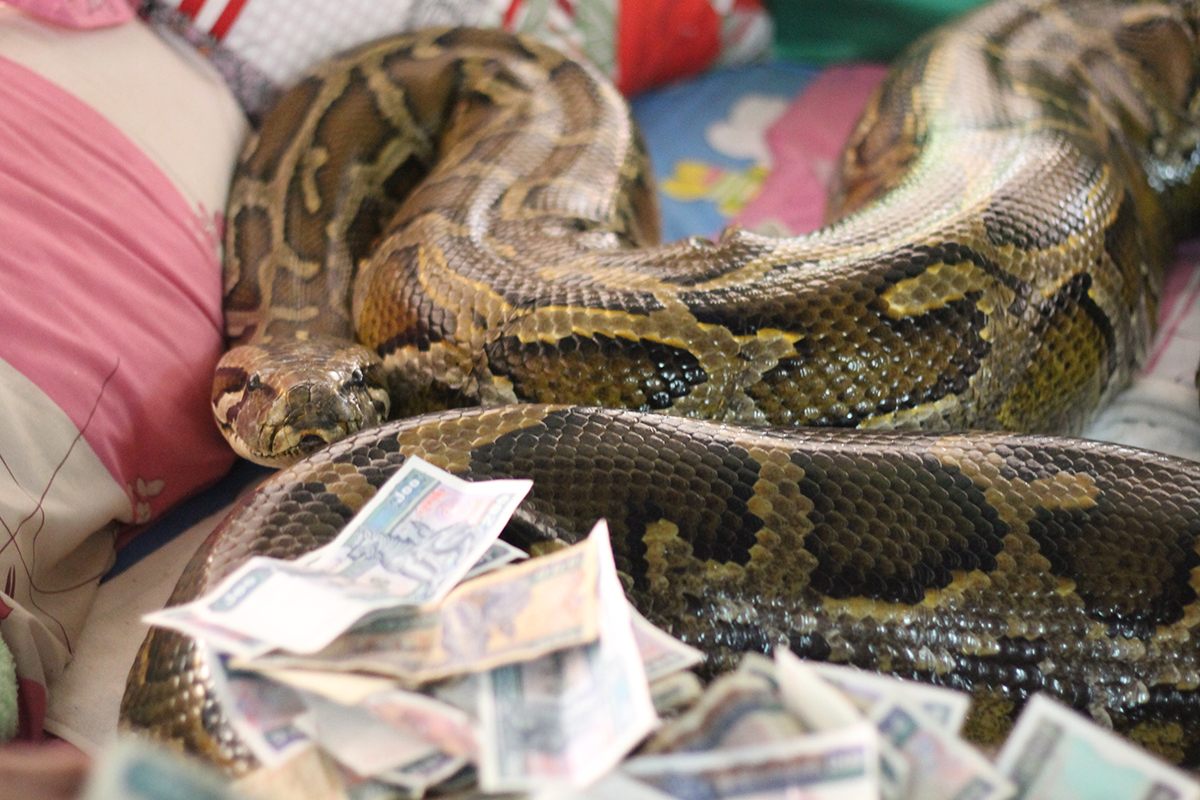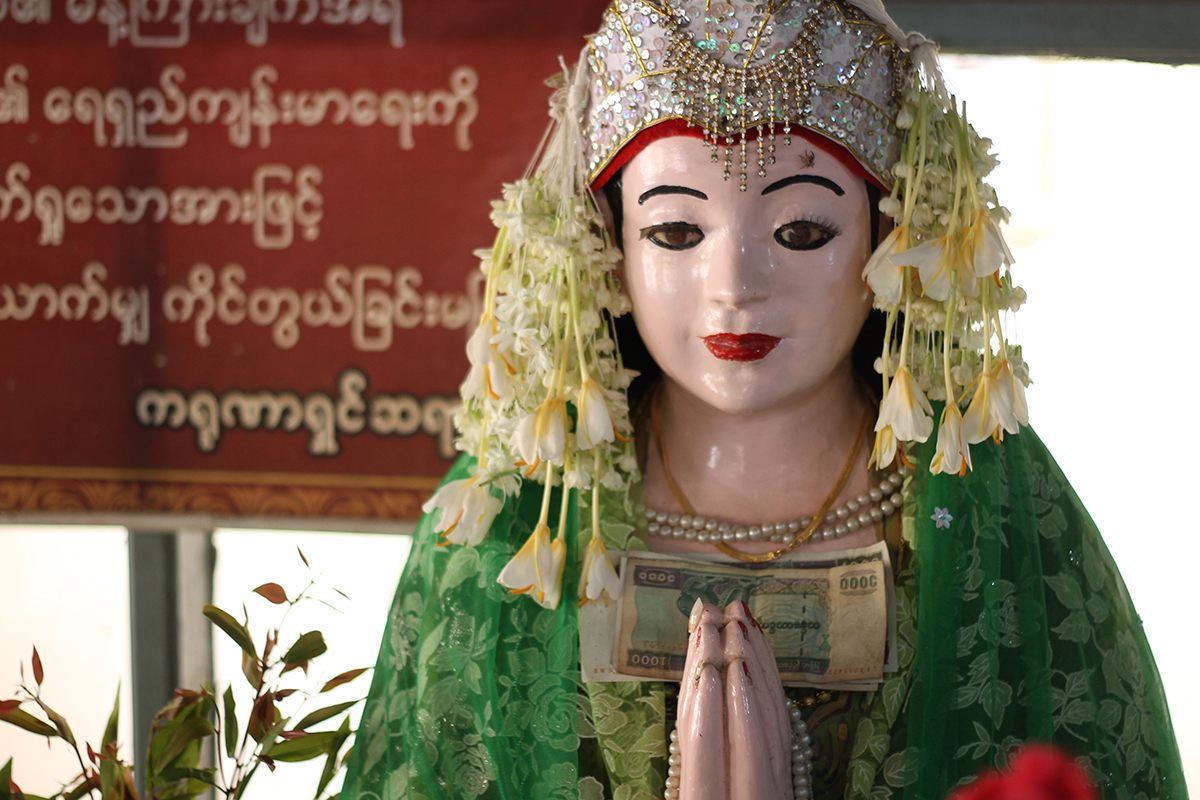An Afternoon with a 14-Foot Python Covered in Cash, Believed to be a Reincarnated Princess

The Burmese python in her cage in front of a crowd. (All Photos: RJ Vogt)
At the end of a dirt road that twists along Bago River in the old Myanmar capital of Bago, just a 90 minute train ride from country’s largest city, Yangon, a serpent of epic proportions sits on a bed of cash.
The piles of kyat, Myanmar’s paper currency, grow higher as the crowds gather to pay tribute to the snake. Docile, she lazily stretches and poses for the flashing smartphones.

All around her, normal monastery business goes on, as she lives in a compound with about 50 monks. But this animal is not your ordinary garden snake–at more than 14 feet long and over 200 pounds, the Burmese python at Kyi Taung Monastery is believed to be the reincarnation of a former Shan princess and may be one of the largest snakes living in captivity in the world.
She is also, allegedly, 127 years old.

She is believed to be the reincarnation of a former Shan princess.
The journey of this creature involves more than a little bit of faith, as the events don’t conform to rational explanation. But the effects of having the python on the grounds of the once-obscure monastery are quite tangible. Construction, jobs and visitors now flow into the place; every day, devout Buddhists from the surrounding area make the trip to lay their tribute on her massive back in hopes of good fortune and wishes-made-true.
U Aung Than, a local resident who has organized charity donations to the monastery over the last 22 years, said the snake first arrived in a Yangon pagoda 17 years ago.
Monks and townspeople were obviously alarmed by the appearance of the massive python, and immediately began to call for her placement in a zoo–or at the very least, her return to the wild.
As the community discussed what to do with the frighteningly large python, a young girl, only 14 or 15 years old, began to speak.

A statue of the former Shan princess Saw Nan Wai stands in the corner of the python’s chambers.
“The snake let the head monks know by possessing a little girl and speaking through her,” U Aung Than explains as we sit on benches outside the one-room enclosure that forms her home in the monastery. “She told the people, ‘I do not allow to be sent to a zoo. There is a monastery in Bago that my grandfather built, and it is starting to rot. I want to help rebuild this pagoda–send me to this monastery.’”
According to the girl, the snake was actually the reincarnation of Saw Nan Wai, the daughter of the last Shan King who was orphaned as a child and raised by a hermit monk in the Shan hills. She said she was 110 years old, having slithered all the way from Hsipaw , a town in the center of the country, a trip of more than 820 kilometers.
As U Aung Than tells it, the crowds were understandably skeptical of the little girl’s story. It sounded too fantastic to be believed, so they got in contact with the monastery in Bago and asked the monks if her tale was true—were their buildings decaying? Had they heard about this snake, or the story of a Shan princess raised by a hermit in the Shan hills.

The snake brings in about $80 per day in donations, says the monastery’s charitable donation manager U Aung Than.
Little did they know that the monastery’s head monk, U Zar Gada, had learned of the snake in a dream. She had visited him in his sleep, informing him that he was the reincarnation of the former hermit monk who raised her in a former life. (A belief in reincarnation into animals is not uncommon in the Theravada Buddhist tradition practiced by the vast majority of Myanmar people.) Now reincarnated as a Burmese python, Saw Nan Wai sought to reunite with her spiritual father and help to save his struggling monastery.
Walking around the grounds, it is hard to imagine someone describing this monastery as “struggling”. Six pagodas surround the building, glittering golden spires that dot the otherwise remote location. The monastery itself, a low building situated adjacent to the snake’s quarters, is in good shape, with walls unmarred by cracks and a relatively clean washing and toilet facility.
U Aung Than says that all six pagodas have been built since the monks received Saw Nan Wai, thanks to donations she generates. The building she is housed in, as well as three others in the complex, are also by-products of her lucrative presence.
“She earns one lakh (100,000 kyat) per day, on average,” he explains, smiling. To put that in context: In a country whose gross national income, per capita, is just US $1,270, according to the World Bank, she is making roughly 22 times more than the average Myanmar household.
The money piled atop her scales comes from the hordes of local tourists that turn out to visit the famous serpent. On a typical Saturday, U Aung Than said she sees roughly 800 to 1,000 visitors, though weekdays temper that volume to more like 100 or 200.
On her monthly feeding days, when she eats 17 or 18 chickens, the crowds can be even larger.

She has never harmed anyone, but because she is holy she is not to be touched.
Some believe she grants wishes, even bidding on pieces of her skin after she sheds for tangible scales of good luck. As construction begins on a seventh pagoda, it’s easy to see why the monks and crowds of mostly local tourists treat her like the princess she is purported to be. She transformed their lives—who’s to say she doesn’t fulfill wishes?
Still, 127 years is a long time for a snake. It’s hard to believe she’s as old as they think she is. The typical Burmese python lives up to 30 years in the wild and 40 years in captivity, which would make her by far the oldest python ever known to exist. (According to a representative at Reptile Gardens, a wildlife center in South Dakota, the longest living snake made it to 48 years; an 127 year-old snake would “extremely hard to believe or just impossible.”)
U Aung Than said they checked her age when she arrived with a snake expert, who guessed she was about 110 years old (exactly as she had said, through the girl). He and the monks he cares for believe she’s just getting started—because she is a reincarnated princess, he said she will live to be 1,000 years old.
She might need more than seven pagodas for all of that kyat.








Follow us on Twitter to get the latest on the world's hidden wonders.
Like us on Facebook to get the latest on the world's hidden wonders.
Follow us on Twitter Like us on Facebook